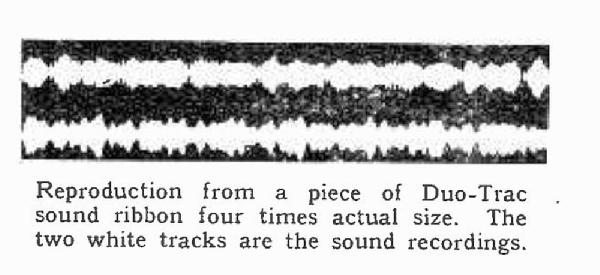Description of the Duo-Trac System - Wireless World 1937.
Description of the Duo-Trac System - Wireless World 1937.

Wireless World March 19, 1937 Page 277.
NEW SYSTEM OF
Recording on Film
DUO-TRAC SOUND PROJECTOR
The average gramophone record gives a playing time at normal speed of about three to four minutes, and this naturally imposes a limitation on the amount of matter that can be recorded on a single disc even allowing for the fact that both sides can be used. The advent of automatic record-changers has gone a long way towards relieving the tedious business of replacing records, and with these useful machines, it is quite possible to obtain half an hour's entertainment without any attention on the part of the user. It is inevitable that intervals occur in the reproduction while the mechanism is changing the record.
In order to obtain a continuous recording for a longer time than is possible with the orthodox gramophone disc, the idea of using film, or its equivalent, and recording the sound on it, has occupied the attention of some research workers in the past, and though many of these systems have not progressed beyond the laboratory stage, a few, among which is the Duo-Trac Sound Projector system, have been developed to a state where they can rightly be regarded as practical commercial propositions.
The firm responsible for the development of the Duo-Trac system is British Ozaphane, Ltd., 72a, Carlton Hill, St. John's Wood, London, N.W.8. It derives its description Duo-Trac from the fact that the film used two soundtracks recorded. During reproduction the film unwinds from one spool to another, playing in the process one of the soundtracks. When this is completed, the driving mechanism is automatically reversed, and the film is wound back again onto the first spool, reproducing the second soundtrack in the reverse winding direction.
On a spool of 7” diameter sufficient film can be accommodated to play for twenty minutes in each direction, but the standard length of film used gives about thirty minutes total playing time.
One great advantage of the forward and reverse method of recording, using two soundtracks, is that on completion the spool is ready for the next time of playing, and does not require rewinding. The amount of film needed for a given playing time is also only half that which would be required were a single soundtrack used.
There is, of course, no definite limitation to a thirty-minute playing time, and should a particular recording not require the full amount of film, less can be used. Likewise, it is possible to extend the continuous run of the record beyond the half-hour period and provide an hour's continuous entertainment on one spool. The material used is a narrow ribbon 4 mm. wide, and it is extremely strong. It can, therefore, be driven without the aid of sprocket holes, which, in addition to enabling the width of the film to be reduced to the bare minimum necessary to accommodate the two soundtracks, also gives smooth running free from snatch, and as a consequence the film has an indeterminate life. The material, which is described as Ozaphane, is non-inflammable.
No wear or tear is imposed on the soundtracks during reproduction, as this is effected by means of a lamp and a light-sensitive cell.
In making the film it is first dyed with a special light-sensitive dye and the soundtracks are produced by a photographic process. The film is not coated with an emulsion as in the case of ordinary photographic film.
Duo-Trac sound film is very durable, and it appears impossible to damage it by scratching the surface, which is smooth and glossy on both sides, while the dye apparently penetrates well into the material.
An extensive program, which includes a monthly release of new recordings, is planned, and the apparatus soon to be generally available consists of a Duo-Trac Sound Reproducer with which is combined an all-wave radio chassis.
The radio receiver is of conventional though quite up-to-date design, and the cabinets in which the apparatus is housed are exceptionally well made. For Duo-Trac sound reproduction a small preamplifier is brought into use to augment the amplification provided by the AF stages in the radio receiver.
The frequency range that can be recorded on the film is very wide, and no mechanical considerations need to be taken into account to restrict the upper limit.
 As mentioned already, reproduction is by means of a light-sensitive cell, which in the illustration is enclosed in the dome-shaped housing immediately below the long metal casing with louvers that accommodates the lamp. The ribbon can be seen between the two and shown also are the guide wheels to maintain sufficient tension on the ribbon to ensure smooth running.
As mentioned already, reproduction is by means of a light-sensitive cell, which in the illustration is enclosed in the dome-shaped housing immediately below the long metal casing with louvers that accommodates the lamp. The ribbon can be seen between the two and shown also are the guide wheels to maintain sufficient tension on the ribbon to ensure smooth running.
Two Duo-Trac sound and radio receivers are in the course of production; one is a table model and the other a console type.
To thank the Author because you find the post helpful or well done.
